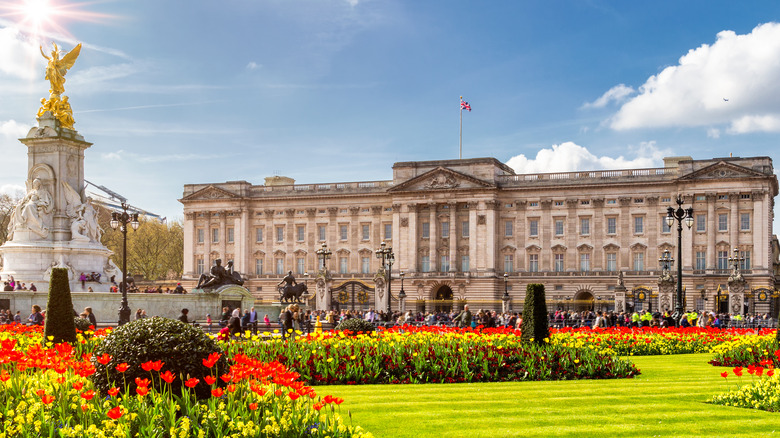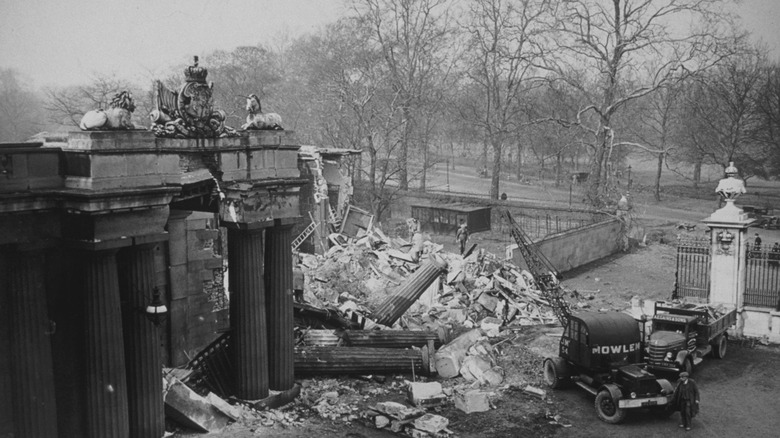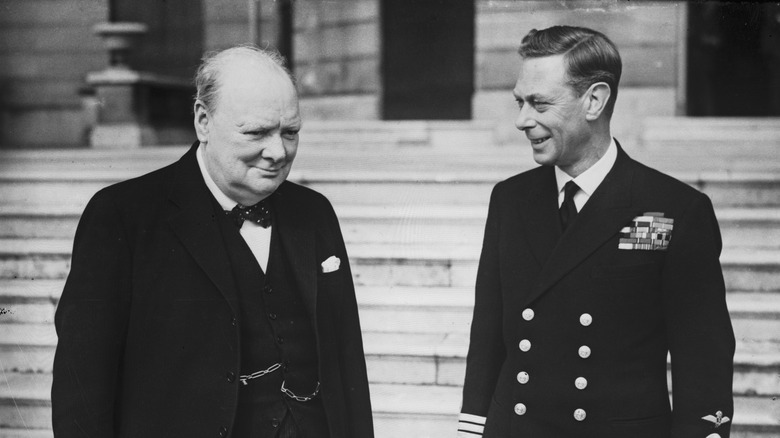The Truth About The Time Buckingham Palace Was Bombed
When we think of the location where World War II took place, maybe people think of Germany and other mainland European countries. But while World War II began in mainland Europe, in fact, fighting expanded beyond the bounds of the European continent, according to Stockton University. In Asia, battles took place between Japanese and American forces over territories like Korea and Japan. And aggression also made its way across the English Channel to Great Britain, too. Though the United Kingdom didn't see ground-fighting during World War II, the country faced significant damage from bombings and other aerial attacks, including during the months-long aerial bombardment called the Blitz, part of the Battle of Britain, according to History.
Carried out by Nazi Germany, the Blitz began on September 7, 1940 and continued into May of 1941, according to Britannica. Attacks were coordinated around strategic locations, including major cities like London. When the British government first declared war on Germany in September of 1939, they prepared for a potential aerial attack by evacuating as many as 1.5 million children from major urban areas. The children were moved to safer locations in the countryside, which were less likely to be attacked. Still, more than 43,000 civilians were killed during the Blitz, according to Imperial War Museums.
But it wasn't just civilians who were affected. The bombings threatened the head of the British government, too, when the royal family found itself in the line of fire.
Buckingham Palace was bombed during the Blitz
Buckingham Palace, in London, was hit by multiple bombs during the Blitz, some of which detonated and some of which did not. The first attack came on September 8, when a 110-pound bomb landed without detonating (via British Heritage). On September 9, another bomb hit that failed to detonate. In the controlled explosion used to destroy the bomb, the palace swimming pool was destroyed, This time the explosive went off, destroying the palace swimming pool, damaging one wing of the palace, and blowing out some windows (via West End At War).
But the most significant attack occurred on September 13, less than a week after the Blitz began. At the time, King George VI and his wife, Queen Elizabeth, were drinking tea. Five bombs fell on the palace, according to British Heritage, an attack that reached from the royal chapel to the palace gates. When describing the moment of the attack in her diaries, Queen Elizabeth wrote, "It all happened so quickly that we had only time to look foolishly at each other, when the scream hurtled past us and exploded with a tremendous crash in the quadrangle. I saw a great column of smoke & earth thrown up in the air, and then we all ducked like lightning into the corridor" (via Royal.uk).
King George also described the moment in his diaries, writing, "All of a sudden we heard an aircraft making a zooming noise above us, saw 2 bombs falling past the opposite side of the Palace, & then heard 2 resounding crashes as the bombs fell ... The whole thing happened in a matter of seconds."
The aftermath of the bombing
Though the king and queen emerged from the attack unharmed, tragically, the same was not true for everyone at the palace, according to West End At War. Four workers who were at the palace at the time of the attacks were injured, and one of them died later from their injuries. The palace also saw significant physical damage due to the attacks, including a ruptured water main and blown-out windows on some buildings.
The royal family was reportedly advised to leave the country after this attack, but they refused, according to British Heritage. Their resolve and courage helped set an example that boosted morale across the country.
Moreover, the attack served as a sort of turning point for Queen Elizabeth. The East End, a notoriously poor section of London, had been devastated repeatedly by air attacks. Of her own bombardment, the queen said, "I am glad we have been bombed. It makes me feel like I can look the East End in the face." Throughout the Blitz, the queen would go on to visit many different areas of the country which had been affected by the bombing, including those where homes had been attacked, as had hers, according to Imperial War Museums.


